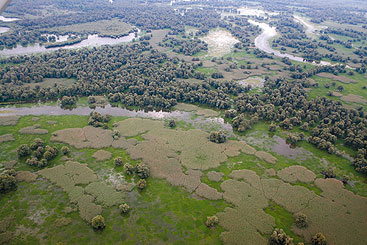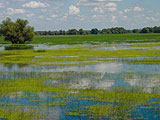
Kopački rit – wetland paradise in limbo between ongoing threats and future protection
One of the most important wetlands in Europe, the Kopacˇki rit Nature Park preserves floodplain ecosystems, hosts a wide diversity of life and earns its place as one of the treasures of the Danube River Basin.

Kopački rit is one of the biggest floodplains of the Danube and Drava rivers and more than 400 registered plant species demonstrate the great diversity of this region.
Located in the Baranya region of north-eastern
Croatia at the confluence of the Danube and the
Drava, the Kopački rit Nature Park is one of the
most important intact wetlands in Europe. The
beauty of the intact nature, and the multitude of
waters, flora and fauna, attract not only excursionists
and visitors but also many experts and
scientists from all over Europe.
Fluctuating water levels in the area create a wide variety of habitats and generate high biological diversity. Within the park there are over 460 species of vascular plants, 294 bird, 56 mammal, 55 fish, 11 amphibian and 10 reptile species. Kopački rit has served as a shelter for many species in the past and is therefore a ‘gene pool’ for many healthy species as well as a refuge for endangered ones.
Kopački rit is an inner delta wetland with distinct morphological and sedimentological characteristics. It was formed during Pleistocene and Holocene epochs by tectonic subsidence that turned Danube and Drava rivers into their present stream directions. The hydro-geological and meandering processes of the two rivers turned the whole floodplain into a mosaic of lakes, marshes, wet grasslands, reed beds and riverine forests.
The area is flooded annually – one month on the higher parts and up to three months on the lower parts, usually from March to May. Water starts to enter the floodplain when the Danube’s water level at Apatin gauging station reaches 300 cm. During the year the water level fluctuates 5–7 m on average, while the maximum-recorded fluctuations are 9.40 metres.
THE KOPAčKI RIT NATURE PARK
Date of foundation: 1967;
protection confirmed and protected area
enlarged in 1999
Area:
23,126,28 hectares (including Special
Zoological Reserve)
Rivers: Danube, Drava
altitude: 78–83 metres above sea level
Number of observed bird species:
294 (including 140 breeding species)
International importance:
Kopački rit Ramsar site, Important Bird Area (IBA)
Areas of high importance:
Kopački rit special zoological reserve (7,143.21
hectares, IUCN category I), Podunavlje fishponds
(650 hectares), Buda-Petres-Mentes floodplain
(approx. 7000 hectares)
Visitor centre: Near Kopačevo village
Nature trails:
Mali Sakadas nature trail, Veliki Sakadas nature
trail, Sakadas-Podunavlje nature trail, Tikves castle complex trail
Website: www.kopacki-rit.com
Remarkable biodiversity. Kopački rit supports 20,000 water birds during breeding, spring and fall migration, as well as wintering. These wetlands support over 1% of biogeographical or flyway populations of Great Cormorant, Grey Heron, Great Egret, Black-crowned Night-heron, Eurasian Spoonbill, Greylag Goose, White-fronted Goose and Whiskered Tern.
This is the most significant spawning ground, nursery and food source in the central and upper Danube for all the fish species of the area, including species that are listed on IUCN red lists such as Sterlet, Weatherfish, Asp, Crucian carp, European carp, Danube Roach, Striped Ruffe, Streber and Zingel. Mammals include Eurasian otters, European wildcats and 12 species of bats. The area supports important populations of IUCN red list species such as the European pond turtle, European fire-bellied toad and European tree frog.
Kopački rit also boasts some of the most breathtaking flora. Scientists have found and registered around 460 species in Kopački rit, many of which are very rare and can be found nowhere else. The Siberian iris is found only in a few places in Central Europe and usually has only a few blossoms. However, at the beginning of June several hectares of Kopački rit are covered by the showy blue flowers of this beautiful type of iris.
 The Kopački rit Nature
Park is especially renowned
for its rich bird life.
Many of the bird species
that breed in the park are
considered endangered at
both European and global
levels. The park supports
the breeding of 40 pairs
of White-tailed Eagles
Haliaeetus albicilla – the
largest raptor in the area.
The Kopački rit Nature
Park is especially renowned
for its rich bird life.
Many of the bird species
that breed in the park are
considered endangered at
both European and global
levels. The park supports
the breeding of 40 pairs
of White-tailed Eagles
Haliaeetus albicilla – the
largest raptor in the area.Wetlands in danger. Threats to these natural values caused the area to be listed on the ‘Montreux record’ – a record of Ramsar sites where “changes in ecological character have occurred, are occurring or are likely to occur”– due to the cessation of all protection activities during the recent war that took place from 1991–1997. The consequences of the war included termination of all conservation measures during that period, destruction of most of the infrastructure and some deforestation. The area has been fragmented and scattered with un-mapped minefields along the dikes and floodplain with nearly 3000 hectares of mine-susceptible area.
In addition to war-related problems, the area earns its place on the Montreux record for the unsustainable use of natural resources – old stands of alluvial oak forests are under particular threat due to over logging and inappropriate management. Another significant threat to the area is the planned river regulation scheme for the Danube as part of the TEN-T project. River regulation for navigation purposes, including fixing the riverbanks with stone barriers, is already taking place on a smaller scale near the town of Apatin.
 Threats to these natural values caused the area to be listed on the
‘Montreux record’ – a record of Ramsar sites where “changes in
ecological character have occurred, are occurring or arelikely to occur”.
Threats to these natural values caused the area to be listed on the
‘Montreux record’ – a record of Ramsar sites where “changes in
ecological character have occurred, are occurring or arelikely to occur”.Solutions & transboundary cooperation. The ongoing threats triggered broad action for the efficient protection of the site. Kopački rit is part of a wider 80,000 hectare floodplain area that extends through Hungary, Croatia and Serbia. Based on this shared responsibility, a transboundary protection plan is under development to ensure that areas with similar natural values have identical protection status; the same threats are dealt with urgency and stopped in the same way; similar natural values are managed and used in an equal and sustainable way.
Several important steps recently carried out are moving in that direction. The Croatian Ministry of Culture declared the preliminary protection of the still unprotected floodplain areas along the Drava and Danube rivers that would fit the existing protected areas. The Danube/Drava floodplain area has been recognised for its natural values and included in the Croatian National Ecological Network and it will be proposed to be designated as a NATURA 2000 site.
Joint and long-lasting cooperation between the Kopački rit Management Office and the Danube-Drava National Park Directorate has already resulted in a number of transboundary projects for habitat restoration, data exchange and outreach. The next step, supported threats are dealt with urgency and stopped in the by the Hungarian and Croatian governments, is to establish the transboundary biosphere reserve ‘Mura– Drava–Danube’. Last year, the presidents of Croatia, Hungary and Serbia signed a joint declaration aiming to protect and ensure the natural values of this area.
Hopefully, these activities will soon result in a large transboundary site protected and managed for the bene fits of nature and coming generations.
Disclaimer
The information contained in the ICPDR website is intended to enhance public access to information about the ICPDR and the Danube River. The information is correct to the best of the knowledge of the ICPDR Secretariat. If errors are brought to our attention we will try to correct them.
The ICPDR, expert group members, nor other parties involved in preparation of information contained on this website cannot, however, be held responsible for the correctness and validity of the data and information provided, nor accept responsibility or liability for damages or losses arising directly or indirectly from the use of the information conveyed therein.
Only those documents clearly marked ICPDR documents reflect the position of the ICPDR.
Any links to other websites are provided for your convenience only. The ICPDR does not accept any responsibility for the accuracy, availability, or appropriateness to the user's purposes, of any information or services on any other website.
When using the information and material provided on this website, credit should be given to the ICPDR.
